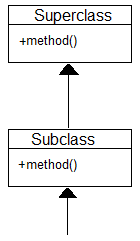CSC/ECE 517 Fall 2010/ch7 7f PW: Difference between revisions
No edit summary |
No edit summary |
||
| Line 1: | Line 1: | ||
=The Call Super Anti-pattern= | =The Call Super Anti-pattern= | ||
==What is the Call Super Anti-pattern== | ==What is the Call Super Anti-pattern== | ||
The Call Super [http://en.wikipedia.org/wiki/Anti-pattern anti-pattern] shows up occasionally in object oriented code. An anti-pattern may be commonly used, but is often considered bad practice or is not effective at producing the desired results. The call super anti-pattern occurs any time an inherited class overrides a method but is still required to call super | The Call Super [http://en.wikipedia.org/wiki/Anti-pattern anti-pattern] shows up occasionally in object oriented code. An anti-pattern is a pattern that may be commonly used, but is often considered bad practice or is not effective at producing the desired results. The call super anti-pattern occurs any time an inherited class overrides a method but is still required to call super at some point during the method. It is not a good idea to require something else being called at some point during the method because the programmer could forget to make the call or do something incorrectly. The reason this anti-pattern is seen a lot in programming is because many languages don't have a way to force super being called from the subclass. One language does however have this feature and that is [http://en.wikipedia.org/wiki/BETA BETA.] <br> | ||
Diagram of Call Super Anti-patter<br> | Diagram of Call Super Anti-patter<br> | ||
[[Image:Callsuper.png|Call Super Anti-pattern]]<br> | [[Image:Callsuper.png|Call Super Anti-pattern]]<br> | ||
Revision as of 01:49, 30 November 2010
The Call Super Anti-pattern
What is the Call Super Anti-pattern
The Call Super anti-pattern shows up occasionally in object oriented code. An anti-pattern is a pattern that may be commonly used, but is often considered bad practice or is not effective at producing the desired results. The call super anti-pattern occurs any time an inherited class overrides a method but is still required to call super at some point during the method. It is not a good idea to require something else being called at some point during the method because the programmer could forget to make the call or do something incorrectly. The reason this anti-pattern is seen a lot in programming is because many languages don't have a way to force super being called from the subclass. One language does however have this feature and that is BETA.
Diagram of Call Super Anti-patter

Example of the Call Super Anti-pattern
In the example below, the super class of TestCase is extended by the TestCaseOne class. The subclass TestCaseOne calls setup at the beginning of its own setup() method and then does any extra steps.
public class TestCase{
public void setup() {
...
}
}
public class TestCaseOne extends TestCase{
public void setup() {
super.setup();
...
}
}
Alternative Implementation
Instead of forcing a method to call super(), it is generally considered a better practice to use the template method pattern. In this pattern, the method that would be required to be called via super(), that method would actually call another method that is abstract has to be created by the subclass.
Example Using Alternative Implementation (Template Method Pattern)
In the example below, the super class implementation of setup() calls another method doExtraStuff() which is abstract and therefore has to be implemented by the subclass when it is extended.
public class TestCase{
public void setup() {
.....
doExtraStuff();
}
abstract void doExtraStuff();
}
public class TestCaseOne extends TestCase{
void doExtraStuff() {
...
}
}
References
[1] Wikipedia, the free encyclopedia: Call Super, 2010. Wikimedia Foundation, Inc.: [1]
[2] MF Bliki: Call Super[2]